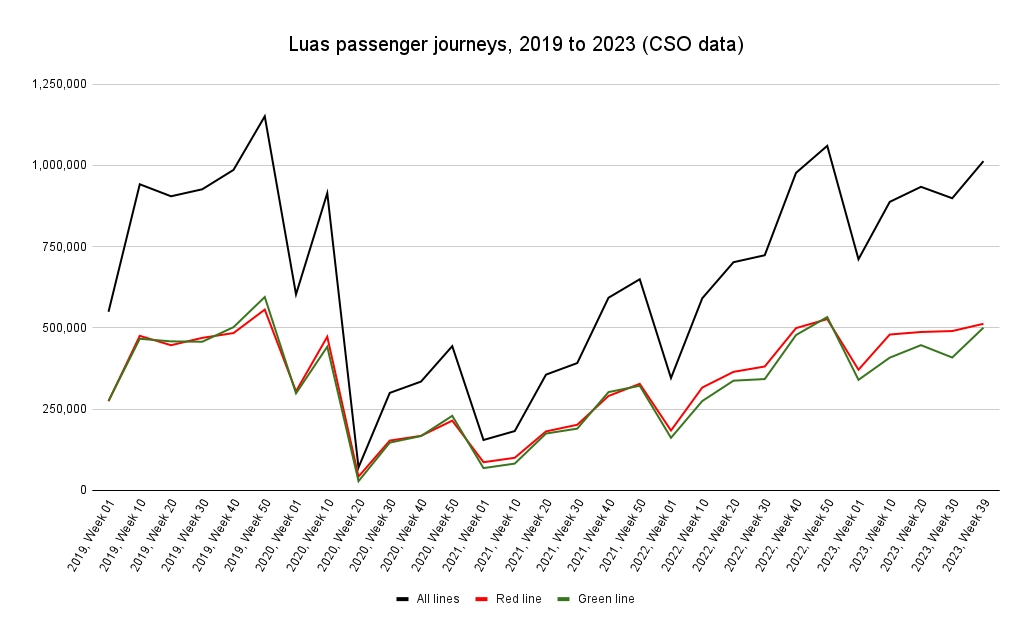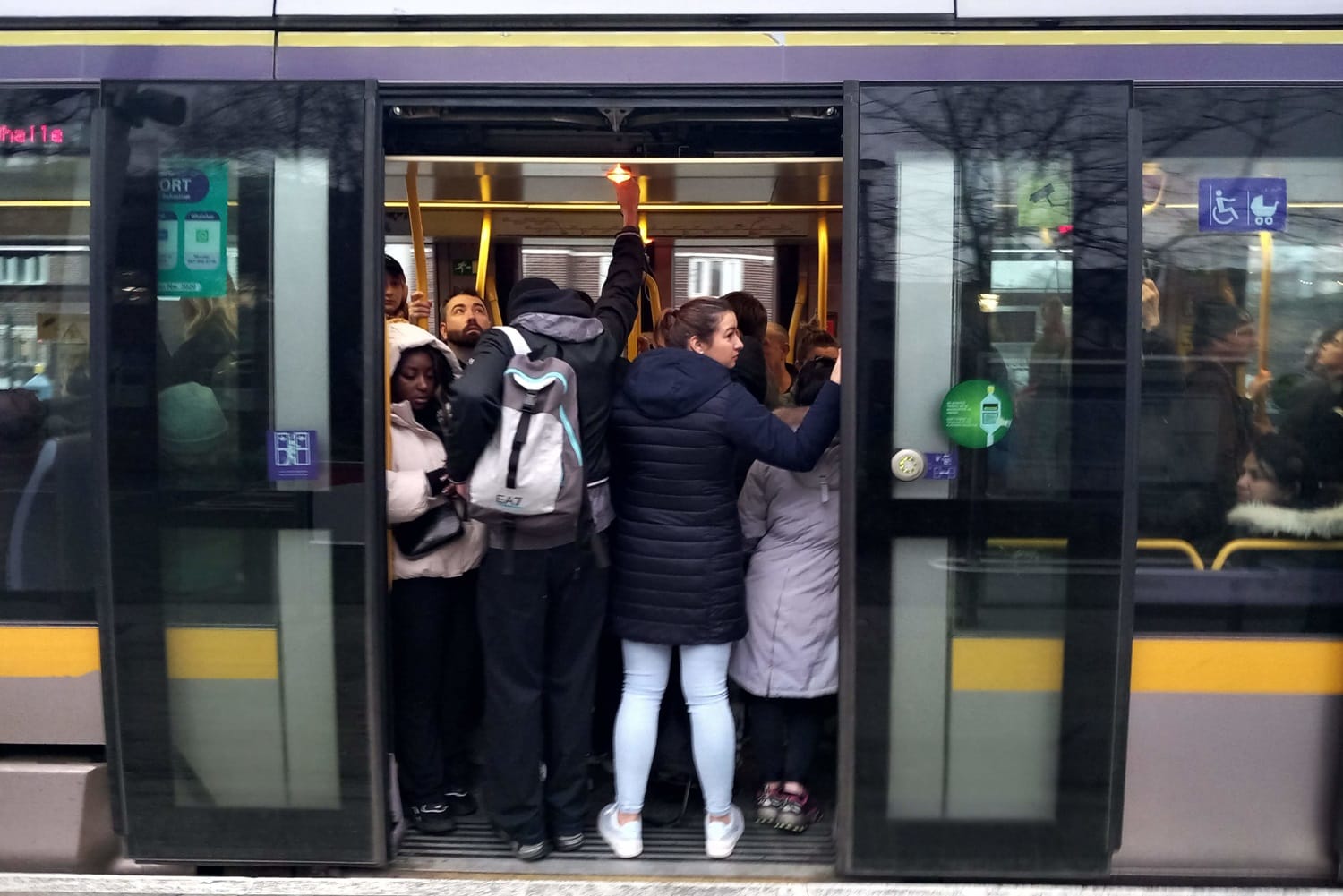What’s the best way to tell area residents about plans for a new asylum shelter nearby?
The government should tell communities directly about plans for new asylum shelters, some activists and politicians say.
But because the Luas shares city streets with other road users, there’s only so much that can be done to expand capacity, says Mark Gleeson, of Rail Users Ireland.

On Monday morning about 9am, Darko Miterd is waiting at the Luas’s Fatima stop, a wooly hat on.
The pale winter sun, low on the horizon, is only touching the top three storeys of the six-storey hospital building behind the stop, leaving everything below – including Miterd – in shadow.
“Usually around nine it [the Luas] is crowded,” he says. “You’d be lucky to get a space on board. And around five it’s the same.”
“Sometimes you need to wait for a couple of Luases to get a tram because it’s too crowded,” he says. “Even then when you get on you’ll probably be all smooshed.”
Miterd says he’s not about to abandon the Luas though. As he sees it, it’s the best available option for him to get to Smithfield and back.
Down the platform a bit, Samantha O’Sullivan is topping up her Leap card at the machine under the shelter.
Unlike Miterd, O’Sullivan says she’s largely given up on the Luas and avoids it as much as she can, in part because of the overcrowding. “You’re like sardines.”
She’s only taking it today because this time of year town is so packed with shoppers that if she were to drive she doesn’t think she’d find a parking spot, O’Sullivan says.
The Luas “is a victim of its own success”, says Mark Gleeson, a spokesperson for Rail Users Ireland.
There are plans afoot to address the problem, a spokesperson for the National Transport Authority (NTA) said Monday.
The NTA and Transport Infrastructure Ireland (TII) “are working together to implement a revised timetable for Luas to increase service frequencies on both Luas lines, including at weekends, using existing tram rolling stock”, he said.
But there’s only so much that can be done, because of how the Luas system was designed at the start, says Gleeson.
The Luas opened in 2004 and in 2005 it handled 22 million passenger journeys, according to TII. By 2019, that figure had topped 48 million.
“The Luas demand blew everyone’s expectations after it launched,” says Jason Cullen, of the Dublin Commuter Coalition. “Well everyone in Government anyway.”
Luas ridership crashed during the Covid lockdowns, but has bounced back. It’s now basically back to pre-Covid levels, according to CSO figures.

“Demand on the Red Luas line has grown faster than on the Green line over the last 18 months as passenger numbers recovered post COVID,” said an NTA spokesperson.
“Red Line trams have been particularly busy at certain times in recent weeks, due to tram shortages associated with maintenance issues at the Red Cow depot,” he said.
However, few passengers put in complaints to the Luas call centre about overcrowding on the trams, according to the TII’s most recent Luas performance report, for the second quarter of 2023.
Of 1,761 complaints recorded in the report, only 19 were about overcrowding. Most were about disruptions of service (602), or anti-social behaviour (418).
Indeed, anti-social behaviour was top of mind for O’Sullivan, the woman waiting at the Fatima Luas stop on Monday.
Although she said overcrowding was a problem too. So did other customers waiting that morning on the platform.
Briam McCormack, who was on his way in to Henry Street, among them. “It’s getting home from town that can be a bit jammed,” he said. “But it’s a good service.”
And Mia Huang too. “Sometimes it’s overcrowded in the mornings and on weekends,” she said. “It’s fine though most of the time.”
Overcrowding is a problem not only on the Red line but also on the Green line, according to a July statement from TII.
It’s so crowded at the Balally and Ranelagh stops that some passengers are “unable or unwilling to board at these stops”, it said.
“Demand projections from the NTA suggest that there is a latent demand for travel on the Green Line where people are not travelling by Luas due to peak period capacity constraints,” it said.
Gleeson, of Rail Users Ireland, points to the Luas performance report for the second quarter of 2023, which shows a disparity in performance on the two lines.
“The Red line performs worse than the Green line and one of the key metrics is excessive wait time, i.e. waiting for a tram longer than expected,” Gleeson says.
“The Green line just about makes the standard, the Red line consistently fails. Delays result in overcrowding,” he says.
Transdev, the company that operates the Luas, is not trying to cram more people into as few trams as possible to make more money, a company spokesperson said.
“Transdev (Luas) is not limiting capacity,” she said. “To change the Red Line timetable or to make adjustments to the tram size ie from 40 metres to 50 metres is a question for TII.”
Since 2017, TII has been working on a €100 million effort to expand the Green line’s capacity “by increasing tram sizes, lengthening platforms and extending the Sandyford Depot”, according to a July statement from the state body.
TII has not responded to queries sent by email on Thursday, or a follow-up on Monday, about plans to increase capacity on the Red line. When called on the phone Monday, a woman at TII advised sending queries by email.
However, one of the obstacles to significantly expanding the capacities of the Red and Green lines so they can handle more passenger journeys is that they share city streets in some places with all other road users, says Gleeson, of Rail Users Ireland.
This limits how often trams can run, and how long they can be. It also means that unrelated traffic problems can delay them.
“So unrelated traffic issues can lead to serious delays and even service suspensions,” he said. The longer the wait between trams, the more people gather on the platforms to get on the next tram.

This problem is most acute on the Red Line from Heuston Station to Connolly Station, according to the NTA’s Greater Dublin Transport Strategy 2022 to 2042.
“Often trams which have been subject to delay become overcrowded at peak hours while the next tram which arrives very soon after, is not close to capacity,” it says. “It also makes it difficult to add capacity to these sections of the line.”
In the longer-term, the NTA believes trams travelling through the city centre should have more of a priority over other road users, the document says.
“This may require grade separation of some crossing movements, particularly in the City Centre,” it says.
The Luas should have been built in the first place in a way that allowed more capacity expansion, says Gleeson, of Rail Users Ireland.
“This is the typical lack of ambition and long term planning with public transport where the fear of failure and financial performance is the focus not the social value and the fact we are building infrastructure for 50/100/150 years to come,” he said.
Both the Red and Green lines are only going to get more crowded, says Cullen, of the Dublin Commuter Coalition.
Thousands of new residents are expected at Cherrywood, on the south side on the Green Line, Cullen says.
Plans for the City Edge project in west Dublin foresee thousands more homes near Red Line stops too.
Gleeson, of Rail Users Ireland, said similar. “The expected large housing developments in Cherrywood, Sandyford etc will strain the system further with no scope to increase capacity,” he said.
Says Cullen, of the Dublin Commuter Coalition: “With the housing crisis pushing people further and further outside of central Dublin, it’s no surprise that our services are over-subscribed.”
Meanwhile, the BusConnects redesign of the city’s bus system – which could help move more people faster – is delayed because of a shortage of bus drivers, and other factors.
Efforts to bring in red-light cameras with automatic number plate recognition, to better enforce bus lanes, Luas crossings, have been on the slow track.
And plans to add public transport capacity that could take some pressure off the Luas by building Metrolink, Dart+ Tunnel and Dart+ South West are years and years off.
Get our latest headlines in one of them, and recommendations for things to do in Dublin in the other.